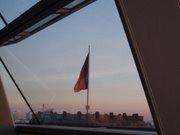


Entre la Marktplatz y el río Weser apaez la cai de los Toneleros..Son un conxuntu de caleyuques estreches que combinen l'arquitectura medieval co'l estilu expresionista de los años 20 y con un encantu particular; Galeries d'arte, bares y restaurantes formen parte de esti pequeñu labrintu tan prestosu// Böttcherstrasse connecting the Marktpalzt and thr Wesser riverside is and incredible combination of medieval buildings and expresionist architecture from the 20's, crowed with bars, restaurants and art galleries

El riu Wesser. A 66 km del Mar del Norte, cunta col segundu puertu n'importancia d' Alemaña, depués de Hamburgo y con una ribera per guapa a pesar de lo industrial/The Wesser crosses Bremen giving the city the 2nd Port-Bremenhaven- in importance after Hamburg apart from a really nice river sights.





The schnoor.El barriu de pescaores fundáu nel sieglu XIII ye el rincón de Bremen que siempre guardo na alcordanza. Cais estreches, cases antigües, xardines de época y piedres que te faen pensar nun tiempu pasáu de marineros, pescaores, piratas y muyeres y homes de buen vivir.Otra cosa que me paez destacable ye que ye la cuna de un típu de xerga o dialeutu que se foi formando a lo llargo de los sieglos como instrumentu comunicativu auspiciau per les transaciones comerciales del puertu.Tratase de un conglomeráu basáu nel alemán, inglés, danés y neerlandés que sigue siendo falau en ciertes partes de la ciudá.Impresionante barriu// Die Schnoor, founded by fishermen around the 13th century and about to be closed during the 50's due to the bad hygienic conditions, is the old part of the city. Its fabolous ancient buildings and garden's lay besides the river.A walk through its narrow streets gets you to another time, that of the taverns crowded with pirates, fishermen and hoes and to its fantastic sailing adventures.Another really nice experience is to see that it's the birthplace of a ancient dialect coming from a mixture of German, English, Danish and Dutch used in the commercial activities of the port and which still today is used by some part of the citizens of Bremen.




Una cerveza pa despedinos de Bremen con la firme promesa de volver otra vez....y una carrerina pa nun perder el tren//A toast to Bremen and the vow of returning. A crazy wee running to cacth the train in the nick of time







